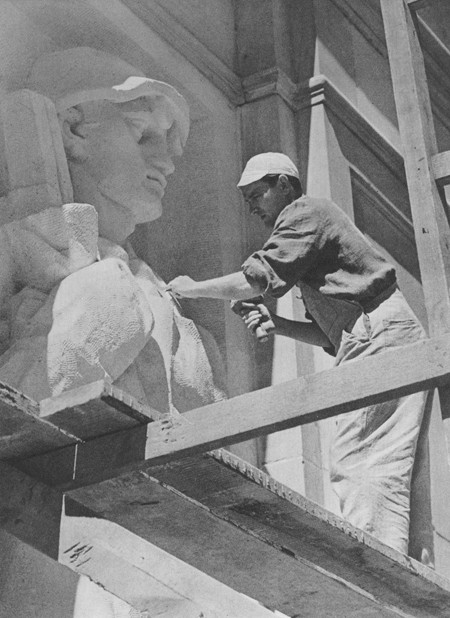In February 1956 Nikita Khrushchev delivered his famous “secret speech,” a trenchant denunciation of Stalin that initiated the process of de-Stalinization throughout the Eastern Bloc. Yet already, in 1954, the emergent Soviet leader had articulated his first public criticism of Stalinism by focusing on the regime’s historicist architecture, whose excessive ornamentation he regarded as a symptom of a greater pathology. Khrushchev’s ensuing directives abolished architectural ornament and mandated rationalized, efficient construction, thus paving the way for the re-espousal of modernism in the Soviet Union and its European satellites. This marked shift in Soviet architecture thus became one of the first and most visible signs of de- Stalinization, which was thus tested out in official aesthetics before its appearance in politics.
During this period of transition, architecture’s status as an art and its ability to communicate political ideals, which had been undisputed under Stalin, were suddenly questioned, as “construction” (stroitel’stvo) displaced “architecture” (arkhitektura) in official discourse. Yet it was still expected that buildings would somehow be “socialist in content” and thus distinct from those of Western capitalist countries. This paradox was negotiated by the integration of ideologically charged painting and sculpture into the new architecture, in what was referred to as the “synthesis of the arts.” Although the concept was also widespread in the West at the time, promoted by such prominent figures as Le Corbusier and discussed in journals such as L’Architecture d’aujourd’hui, it took on a particularly politicized, utopian character under state socialism.
My dissertation examines the synthesis of the arts as both a theoretical construct and a practical application in post-Stalinist Eastern Europe, as it operated at the intersection of aesthetics and politics. The discourse on synthesis articulated the place to which art aspired in socialist society: by abandoning galleries and joining permanent architectural contexts, it would be able to exercise a social function that it had lost under the pressures of the free market. In addition, art would help mitigate anxieties surrounding the mechanization of construction and the expansion of architectural modernism in societies other than Western liberal democracies.
As an elusive and malleable concept with universally positive connotations, the synthesis of the arts provided a rare point of consensus at a time of intense transformations in the art and architecture of the Eastern Bloc. The search for new models of combining art and architecture formed part of the intellectual climate of the time, most notably the new, reformist strands of Marxism- Leninism that emerged after 1956. These reforms sought a “Communism with a human face”: a nontotalitarian, post-Stalinist vision that aimed at salvaging the earlier utopian dreams of an egalitarian society from the Stalinist catastrophe. At its core, the problem of the synthesis of the arts was a sociopolitical one: the purportedly nonhierarchical, harmonious community of architects, artists, craftspeople, and workers from which it would emerge was often envisioned as a microcosm of the new, classless society that was yet to come.
Stalin’s death in 1953 accelerated a process of splintering among the socialist countries of Europe that had already begun with the Yugoslav-Soviet split of 1948. As these countries embarked on their own “paths to Communism,” diverse visions of synthesis took shape in their differing political contexts. This project focuses on public buildings and exhibition pavilions as well as theoretical texts and unrealized projects from three countries: the Soviet Union, the undisputed political center of the bloc; the People’s Republic of Poland, its largest satellite, which became a center for reformist thought; and nonaligned Yugoslavia, which sought to develop its own brand of socialism while retaining close contact with both the West and the Third World.
The broad geographical span is counterbalanced by a sharply focused chronology that allows for a close examination of this paradigm shift. Beginning in 1954 with the first signs of aesthetic change, it concludes in 1958, when the new socialist-modern mode of synthesis reached its apogee with the Eastern Bloc pavilions at the Brussels World’s Fair. These five years correspond to a brief phase of renewed faith in mass utopia when the practices examined in my dissertation were still firmly inscribed within official state culture, before the constitution of a separate, dissident Eastern European sphere during the 1960s and 1970s. At a moment of precipitous aesthetic and political change in a multipolar world of superpowers, satellites, and nonaligned states, this was a distinct time and place in which it was still possible, perhaps for one last time, to be both avant-garde and Communist.
